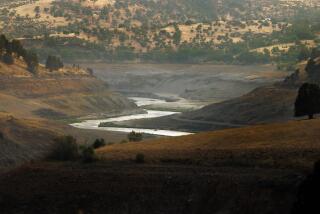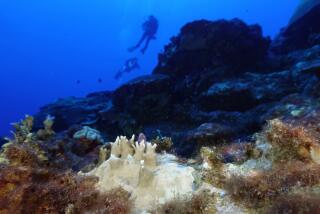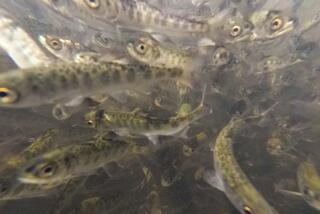Turning the Tide on an Eco-Catastrophe
BIRLESTIK, Kazakhstan — In the dried-up harbor of this dusty village, camels roam next to forlorn ships seemingly washed up by tides of sand.
Near the rusting hulks, a camel herder dreams of what once was -- and what might be.
“They say that maybe there will be water here again,” Dosym Kutmambetov, the 27-year-old grandson of a fisherman, said as he paused from rounding up his family’s herd. “We’re dreaming that the water will be here very soon. It makes my heart glad. If the sea is full, more people will come back to the village and life will be richer. If the sea comes back, I’ll catch fish too.”
The hope is not just wishful thinking.
Over the last half a century, the Aral Sea shrank to less than half its original size and turned salty as irrigation diversion slowly drained what was once one of the world’s largest lakes. Like a gigantic amoeba, the landlocked sea divided in two in the late 1980s. The shrinkage not only wiped out a large fishing industry but blanketed the region with toxic saline dust blown up from the dry seabed.
Now, thanks to a new 8-mile-wide dam and other projects by the Kazakh government and the World Bank, the northern part of the Aral is filling again with fresh water. That in turn is restoring hope and a modest degree of prosperity to a region devastated by the double whammy of a disappearing sea and the Soviet collapse.
Fat carp flop wildly as fishermen pull nets tight around them, and salted fish hang to dry in the semidesert region’s processing plants.
“I’m happy. The sea is coming near my village. I had a son born yesterday. And along with the sea, the fish come to the nets,” Zhanarbek Kelmaganbetov, 30, said as he paused from hauling in 2-foot carp near the new dam.
The southern sea, which lies mostly in Uzbekistan, continues to shrink and is too salty to sustain even ocean fish. Instead of trying to reverse the environmental damage there, Uzbekistan’s government is seeking to find and develop gas and oil deposits in the dry seabed.
The dam that is restoring life to the northern sea, which lies entirely within Kazakhstan, has raised the water level there to 138 feet above sea level. That compares with an elevation of 126 feet last summer, before the dam was finished.
Residents take great pride in the reversal of what has long been considered one of the world’s greatest man-made environmental disasters. Such a dramatic ecological success is particularly rare in the former states of the Soviet Union, which have not had the resources to clean up mistakes made under communist rule.
“There are seven wonders of the world, and the eighth is the dam on the Aral Sea,” said Kolbai Danabayev, vice mayor of Aral city, a former fishing harbor known in Soviet times by its Russian name, Aralsk, and located about 30 miles northeast of the dried-up Birlestik harbor. “No one has done something like this before.”
Many fishermen and local officials want to see the dam raised enough to restore the entire northern Aral to an elevation of 174 feet, the sea’s level before the shrinkage began. Experts say that would be too expensive, but that raising the water to 151 feet would be enough to bring key harbors back to life.
The initial push to revive the northern sea came from the local populace and regional government, with special contributions and taxes used to construct temporary experimental dikes out of sand. The first, built in 1992, was washed out the next year, but it proved that a dike could raise the sea level and the water’s quality.
A bigger dike was built a decade ago, and it helped launch a modest revival of the fishing industry. But that dike, located where the new dam is today, failed during a 1999 storm.
Murat Abenov, 59, who witnessed the decline and fall of the region’s fisheries, today spends his time fishing near the dam, 70 miles southwest of Aral city. Life for fishermen is already richer now than it was in the Soviet era, he says.
“At that time we had a big sea, and we caught fish with big boats,” he said. “But in those days you caught the fish and turned them over to the fish-processing plant. Now you catch fish and sell them yourself as your business. That’s why life is much better now.”
For the fishermen who pulled in 50,000 tons a year half a century ago, the Aral Sea’s death came stealthily. The shrinkage and growing salinity -- which killed all native freshwater fish by the late 1970s -- was little understood at first.
The sea’s tragedy began around 1960, when Soviet planners sharply increased the use of irrigation water from the Aral’s two tributaries, the Syr Darya and Amu Darya, to boost cotton production in Uzbekistan and Kazakhstan, then part of the Soviet Union. By 1966, the fishermen realized their sea was shrinking. A few years later, the fish began to die.
Many fishermen thought the sea was shrinking from natural causes, and at first they suspected the fish were dying because of some accident on Vozrozhdeniye Island, used for decades during the Soviet era as a biological weapons testing ground.
“Information was very tightly controlled at that time,” Abenov said. “We knew that big boats couldn’t come near this island. People could see from boats in the sea that the fish were dying. Then when it was windy from the far side, fish were thrown up on the shore. We were afraid to eat these fish because we didn’t know what was wrong.”
By the late 1970s, Abenov said, the fishermen started to understand that the sea was shrinking and turning salty because too much water was being taken for the cotton fields.
Tolybai Uikasov, 69, the former mayor of the onetime fishing village of Karateren, blamed the death of the Aral on Soviet-era censorship and repression. Over a period of one or two decades, residents gradually linked newspaper reports of irrigation works and increased agricultural production to the shrinkage, but no one dared resist the policy, he said. Today, the village is a dusty, landlocked settlement.
“Our government was run by the Communist Party, and we were afraid to ask any questions,” Uikasov said. “Of course we couldn’t say anything openly. At that time there was no possibility to hold rallies, strike or petition the government. Nowadays, Kazakhstan has had independence for 15 years and we’re free to say what we think about what’s going on. We wouldn’t allow something like this to be done. But then things were controlled very tightly.”
The last of the native freshwater fish were dead by 1979, and at that time a national fishery institute in Aral decided to introduce flounder, an ocean fish that could survive in salty water. By the early 1990s, the flounder had multiplied enough for small-scale fishing to start up again. But flounder, a flat bottom-feeder that has both eyes on the same side of its head, did not win immediate acceptance.
“The fishermen were frightened,” said Zaulkhan Ermakhanov, an official with the fishery institute. “They were afraid to touch it. It doesn’t look like an ordinary fish.”
Some people thought the flounder were deformed because of pollution, he said. But the fish soon became popular. Because flounder can tolerate low as well as high levels of salinity, they will survive alongside carp and other native species as the northern sea returns to being fresh water, Ermakhanov said.
Saparbai Zhurimbetov, 40, a fisherman from the city of Aral, was just a child when the harbor dried up at Aral. Now he routinely travels 100 miles by mostly unpaved road to fish near the new dam.
“My father is always dreaming about old times, when there were a lot of fish and a big sea,” he said. “I’m more concerned about the current situation. I’m very concerned that the dam be raised. We want the sea to come back to Aral harbor. It’s not easy for us to come from Aral city to catch fish here. We want to catch fish near Aral.”
The dam was built of sand and earth with a very gradual slope on the water side, designed to imitate a natural beach and thereby lessen erosion from waves.
Kazakh government experts are now considering whether to raise the entire northern Aral by enlarging the dam or build a second dam and a canal that would raise the water just in one large bay, in effect creating a two-tier northern sea. Either option would bring water back to the harbors of Aral city and Birlestik.
On a recent evening, Tolagai Myrzabayev, 56, sat on a bench overlooking the Aral harbor, keeping an eye on the family goats grazing in the seabed.
“The water was right here,” he said, motioning to the slope at his feet. “Starting from 1961, it started to go away. At that time, it was a very beautiful place. There was a beer bar. My brothers and uncles would drink beer, and we were fishing here.”
Then he pointed into the distance, where the remnants of a few landlocked ships could be seen at the far end of the harbor.
“That white thing there is a piece of the ship Kirov,” he said. “In 1979, I was an engine worker on that ship. Then the sea shrank and it was stuck there.”
Beksultan Zharilkasimov, 13, who lives near the harbor, said he had never seen the sea, but he knew from his father that it once was just a few hundred yards from his home.
“I heard that it might come back,” he said, flashing a huge grin. “That would be great. I’ll go fishing!”
More to Read
Sign up for The Wild
We’ll help you find the best places to hike, bike and run, as well as the perfect silent spots for meditation and yoga.
You may occasionally receive promotional content from the Los Angeles Times.






